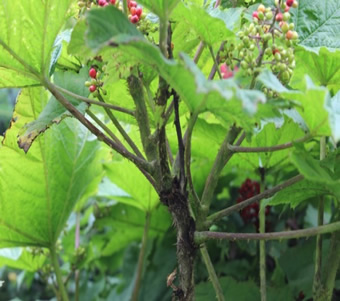Devil's Club

Botanical Name: Oplopanax horridus (p Russell book) Echinopanax horridum (medicinal flora of the Alaska natives)
Common Name: Devil's Club
Other Names: Cukilanarpak (large plant with needles), Alaskan Ginsing
Found in: Undergrowth on moist, well-drained soil
Physical Characteristics: Large, prickly and spiny shrub. 4 to 8 feet tall, forms dense thickets that are difficult to penetrate. The very large “maple shaped” leaves have spines on their veins and stems. The greenish flowers are on a dense woody spike and in august are followed by small reddish berries that also have thorns. (Pratt 1989) The thick tap root contains a soft, pithy inner bark (cambium).
Nutritional Value: Ethno botanic data indicate the extracts of the inner bark appear to have antipyretic, antitussive, and antibacterial properties.
Parts of the plant used: stems (for the cambium), roots
When plant should be gathered: Devil’s club root was gathered and dried for winter use. However, the cambium can be gathered anytime of the year.
Plant applications: Ash, bath, infusion/decoction, poultice. Traditionally a piece of devil’s club helped keep evil away when placed over a door. (Russell 1991)
Reported Benefits: Arthritis, broken bones, burns, colds/flu, coughs/chest congestion, cuts/scrapes, food poisoning, hair problems, infections/inflammation, internal pain, nausea, pneumonia, rheumatism, sore muscles, sore throat, toothaches and diabetes/low blood sugar.
Preparation/Processing: Arthritis, toothaches: Devil club roots were used for toothaches and arthritis in a poltice form. To remove a rotten tooth, the patient bites down hard on a root that has been softened by pounding and then placed in very hot water. This process is repeated for at least several hours the root being reaheated often during the process. For aches and pains the raw roots are tied together and pounded to soften and flatten them into a pad. The pad is placed on hot rocks, then laid in a damp cloth on the affected area, and let there till the roots cool. Theis process is repeated a number of times.
Burns, broken bones, cuts/scrapes: Cambium was chewed until soft and placed on cuts, burns, and broken bones. The root was preferably use. A person suffering from a broken leg which was swollen and infected was successfully treated with this devil’s club poultice.
Burns: Devil’s club ash was used as a burn treatment (Birket-Smith 1953)
Colds/flu, coughs/chest congestion, sore throats, arthritis, heart trouble, and cancer : The cambium of devil’s club, with or without the stem, was boiled for one half to two hours and drunk for colds, sore throats, arthritis, heart trouble, and cancer.
Arthritis, diabetes/low blood sugar, hair problems,rheumatism, sore muscles, pneumonia: One way people treated pneumonia with devil’s club was to boil the root, pour the decoction into a bath using one part decoction to one part water) and have the patient soak in the tub. Soaking in a decoction which was too strong caused blisters. One elder recommended boiling devils club in three gallons of water for six hours. This treatment was used for arthritis as well as pnuemonia. If this decoction was used as a hair wash, it helped hair grow better. One person with diabetes was able to walk easier and generally felt better after drinking a decoction of devil’s club tean and soaking his feet in it. (Russell 1991)
Nausea, food poisoning: Strong devil’s club tea was drunk to induce vomiting (Russell 1991)
WARNING: A note of caution by village elders warned that the plants should be used causiously because they could harm the patient if used incorrectly. (Stanek 1985) Although the hypoglycemic effect has not been confirmed, the continued traditional use of this plant for the management of diabetes suggests that some persons may be sensitive to the hypoglycemic effects of devil's club and should use the plant with caution.
